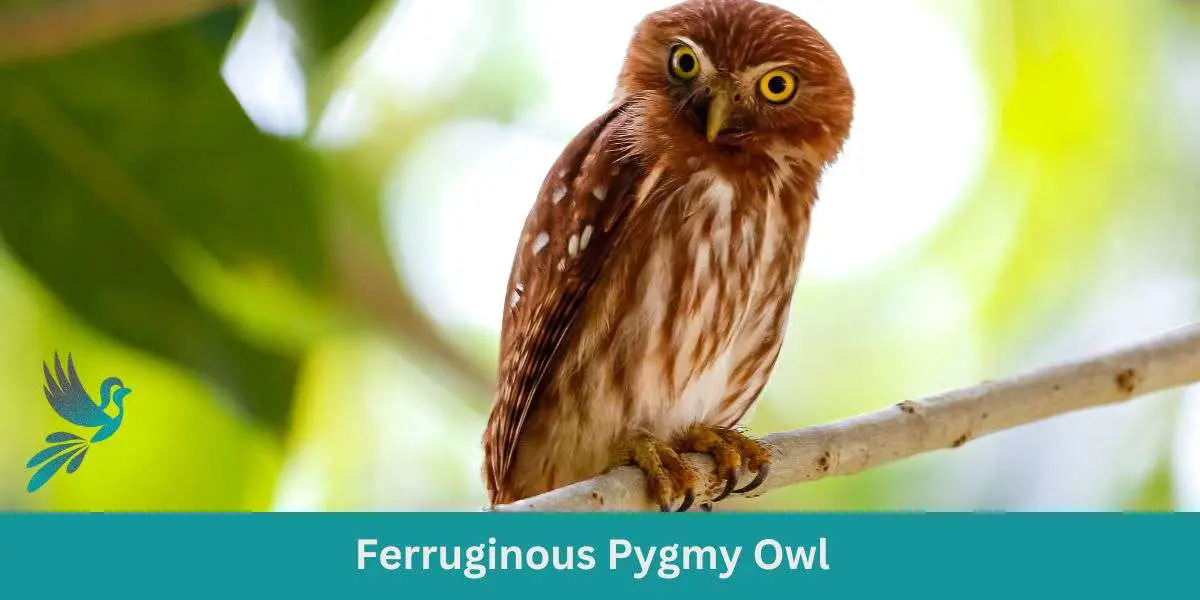Size doesn’t always equate to significance. In the avian world, the Ferruginous Pygmy Owl stands as a testament to this. Though diminutive in stature, its presence in its native habitats is profoundly impactful.
Join us as we dive deep into the fascinating realm of this tiny, yet fierce, raptor.
Overview of Ferruginous Pygmy Owl
The Ferruginous Pygmy Owl, also known as Glaucidium brasilianum, is a small owl species with a distinctive appearance and behavior. This article will provide a comprehensive overview of various aspects of the Ferruginous Pygmy Owl, including its conservation status, habitat, range, physical description, behavior, feeding habits, reproduction, migration, songs and calls, as well as threats and conservation efforts.
Physical Description
- Size and Build: One of the smallest owls, typically measuring about 6-7 inches in length.
- Plumage: Rusty-brown to dark brown upperparts with streaked underparts. Its crown has distinct elongated feathers that resemble “ear tufts”.
- Eyes: Bright yellow, providing a stark contrast to its overall plumage.
The Ferruginous Pygmy Owl is a small owl species, characterized by its distinctive features. It has a small size and exhibits a range of coloration, including reddish-brown, gray, and white.
Its appearance and plumage may vary slightly depending on the region. In comparison to other owl species, the Ferruginous Pygmy Owl is relatively small.
Habitat
- Preferred Habitats: Dry forests, semi-open areas, and thorn scrub. They can also adapt to gardens and parks in suburban regions.
- Distribution: Native to Central and South America, and some parts of North America, especially the southern tip of Arizona and Texas.
The Ferruginous Pygmy Owl can be found in a variety of habitats, including mesquite thickets, desert riverine woods, saguaros, and low stands of live oak and mesquite in southern Texas.
In the past, it was commonly found in mesquite forests along rivers and in deserts dominated by saguaro cactus. In the tropics, it can be found in a wide range of lowland habitats, mostly in semi-open country.
The range of the Ferruginous Pygmy Owl is limited in the United States, with its presence primarily in southern Texas and Arizona. In these areas, it has become uncommon to rare. However, it is more common and widespread in lowland habitats in the American tropics.
Behavior
- “False Eyes”: The back of their head often has two dark patches, giving the illusion of eyes. This might deter predators from attacking from behind.
- Aggressive Nature: Despite their size, they are known to be fearless and can defend their territory from birds much larger than themselves.
The Ferruginous Pygmy Owl is a diurnal owl, meaning it is active during the day. It is particularly active near dawn and dusk. Despite its small size, it is known to be bold and aggressive. It may exhibit mobbing behavior, where other songbirds gather around and harass the owl when they discover it.
Feeding Habits
- Primary Diet: Insects, small birds, reptiles, and occasionally mammals.
- Hunting Technique: Though diurnal, it prefers hunting during dawn and dusk. It captures prey through a sudden swoop from its perch.
The hunting behavior of the Ferruginous Pygmy Owl is primarily characterized by its activity near dawn and dusk. It hunts by watching from a raised perch and then darting out in rapid flight to capture prey in its talons.
Its diet may vary depending on the region, but it is known to feed on various small animals, including insects, birds, rodents, lizards, and scorpions.
Reproduction
- Mating Rituals: Not very elaborate, with mutual calls playing a significant role.
- Nesting: They nest in tree cavities, often using old woodpecker holes. The female typically lays 2-4 eggs per clutch.
There is limited knowledge about the breeding behavior of the Ferruginous Pygmy Owl. The male defends its nesting territory with a song of monotonous repeated whistles, mostly at dusk and dawn, and sometimes even at night.
The nest site is typically a cavity in a tree or a giant cactus, often an old woodpecker hole. The female is primarily responsible for incubating the eggs, which usually number around 3-4 (sometimes 5).
The incubation period is roughly 28 days. Both parents take part in providing food for the young, with the male possibly doing most of the hunting initially. The young typically fledge at around 27-30 days of age.
Songs and Calls
- Distinct Calls: A series of rapid whistles, often given in a sequence.
- Communication: Their calls are not only territorial but also play a role in attracting mates during breeding season.
The Ferruginous Pygmy Owl has a distinctive call, which is described as a monotonous, repeated, and harsh “poip” sound. It can also produce whistling songs.
The call of the Ferruginous Pygmy Owl is well-recognized by songbirds in its range, who often gather around and mob the owl when they discover it.
Conservation Status
The conservation status of the Ferruginous Pygmy Owl is of concern, as it is now considered endangered or threatened in limited range in the United States.
However, it is still widespread in the tropics, although there has been a decline in some areas. Efforts are being made to protect and conserve this species.
The Ferruginous Pygmy Owl faces threats primarily due to human activities and habitat loss. Protection measures are being implemented to conserve its habitats and populations. Various conservation organizations and initiatives are also working towards the conservation of this owl species.


Leave a Reply
You must be logged in to post a comment.